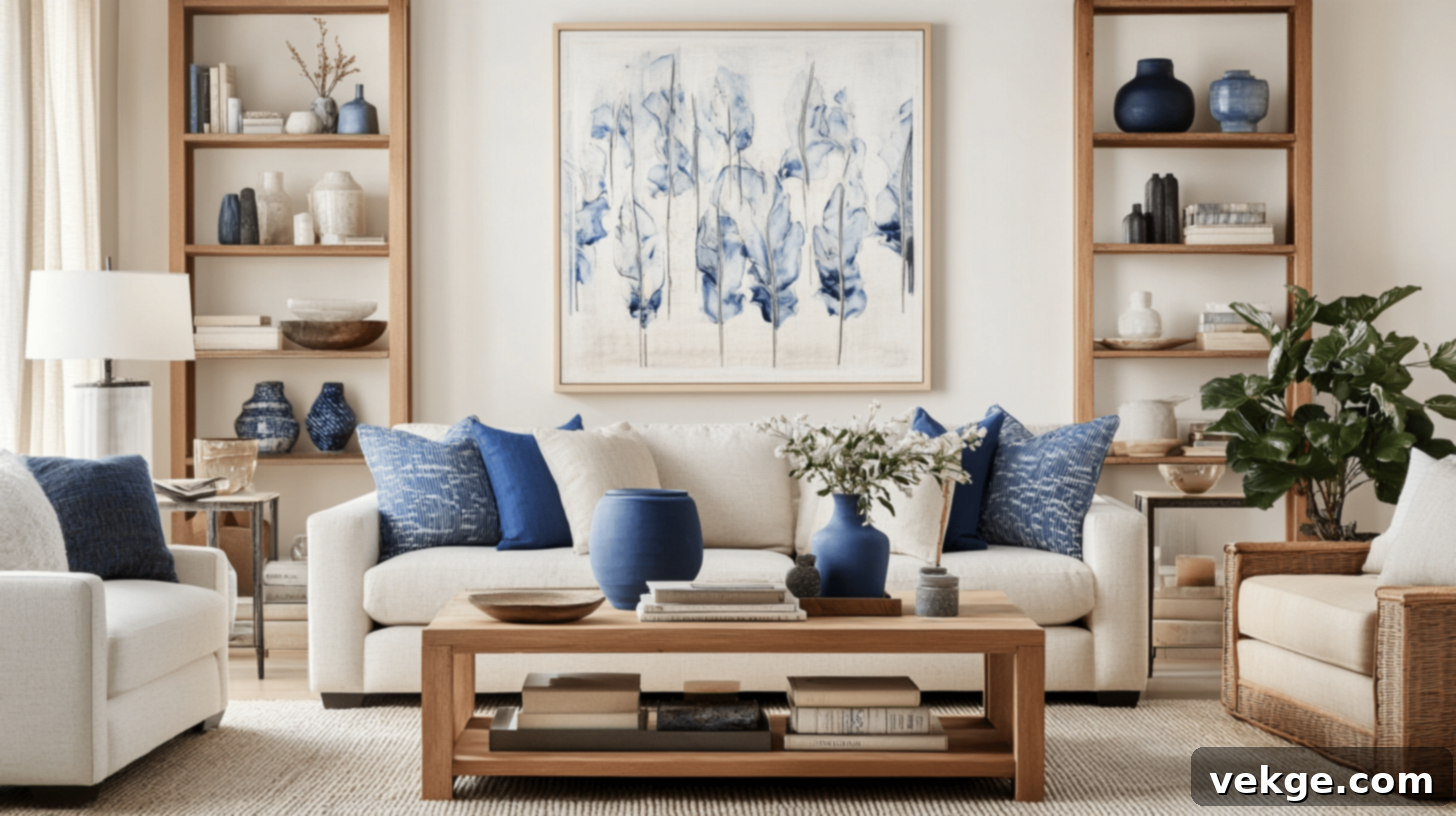Mastering Unity in Interior Design: Create a Cohesive and Harmonious Home Space
Imagine stepping into a space where every element, from the largest piece of furniture to the smallest decorative accent, feels perfectly placed and interconnected. This isn’t just good design; it’s the powerful result of achieving unity in interior design. A truly unified room doesn’t just look good; it evokes a feeling of calm, order, and intentionality, transforming a collection of items into a cohesive narrative.
This comprehensive guide is designed to unlock the secrets of creating such spaces within your own home. We’ll delve deep into understanding what unity truly means in the context of interior design, distinguishing it from the closely related concept of harmony, and explaining precisely why it’s an indispensable element for any well-designed home. You’ll discover the fundamental principles that govern this crucial design aspect and learn how to apply key elements like color, texture, and style to your advantage.
Whether you’re decorating a sprawling family home or a cozy studio apartment, and regardless of your preferred aesthetic—be it minimalist, traditional, or eclectic—we’ll provide actionable insights and practical tips. By the time you reach the end of this article, you’ll be equipped with the knowledge and tools to transform your rooms from a random assortment of items into meticulously planned, complete, and utterly inviting living environments.
What Is Unity in Interior Design?
At its core, unity in interior design refers to the sense of completeness and coherence achieved when all the individual elements within a space work together seamlessly to form a single, integrated whole. It’s the visual glue that binds furniture, colors, textures, patterns, accessories, and architectural features, making them feel like they were always meant to coexist in that specific environment. Instead of a disjointed collection of beautiful pieces, a unified room presents a singular, well-thought-out vision.
Consider a living room where the rich, warm tone of the wooden coffee table is echoed in the frame of the wall art, and a subtle pattern on the throw pillows mirrors the weave of the area rug. The sofa’s upholstery might share a hue with a decorative vase on the mantelpiece, and even the lighting fixtures could complement the overall metallic accents. When these diverse components—couch, coffee table, lamps, wall art, textiles, and even smaller decor items—don’t just coexist but actively reinforce each other’s presence, that’s the powerful effect of unity.
The ultimate goal of unity is to create a space that feels intentional, harmonious, and utterly “right.” It banishes the feeling of randomness or mismatch, replacing it with a comforting sense of order and visual tranquility. A unified room doesn’t demand your attention to piece things together; it effortlessly flows, guiding your eye and offering a cohesive experience.
Unity vs. Harmony: Understanding the Key Differences
While often used interchangeably, unity and harmony are distinct yet complementary concepts in interior design. Think of them as two sides of the same coin, both essential for a successful space, but focusing on different aspects of cohesion. Understanding their nuances is crucial for crafting truly impactful designs.
Unity emphasizes consistency and sameness. It’s about bringing elements together to create a single, cohesive design where everything feels like it belongs to one grand scheme. It often involves repetition, matching, and a strong sense of visual order. Unity strives for a singular, dominant theme or style that permeates the entire space, ensuring no element feels out of place or haphazardly chosen.
Harmony, on the other hand, focuses on the pleasing arrangement of different elements. It’s about creating a sense of agreement and pleasant coexistence among varied components. Harmony allows for variety and contrast, ensuring that even dissimilar items work well together, creating a balanced and aesthetically pleasing whole without necessarily being identical. It’s about balance in difference, where various textures, colors, or styles can coexist gracefully.
For example, a room with strong unity might use the exact same shade of blue across pillows, a rug, and a painted accent wall, combined with furniture all featuring the same dark wood finish. A harmonious room, however, might blend different shades of blue with complementary greens, incorporating a mix of wood tones and metallic accents, all carefully chosen so that while they are distinct, they create a beautiful and balanced visual dialogue. Both approaches lead to a successful room, but unity leans towards consistency, while harmony embraces sophisticated variety.
| Unity | Harmony |
|---|---|
| It makes all elements feel like one whole design | Creates a pleasing mix of different elements |
| Focus on consistency throughout a space | Focus on how different things work together |
| Example: Using the same wood finish on all furniture | Example: Mixing wood and metal that look good together |
| Creates a sense of order | Creates a sense of comfort |
| Works with matching elements | Works with complementary elements |
Why Unity is Indispensable in Interior Design
Beyond mere aesthetics, unity serves as the backbone of a truly well-designed interior. It’s not just about making a space look good; it’s about making it feel right, imparting a profound sense of purpose, direction, and tranquility to your home environment.
Profound Emotional and Visual Benefits
A unified room has a remarkable psychological effect on its occupants. When design elements coalesce seamlessly, the brain instinctively processes the space as organized and complete. This effortless comprehension reduces cognitive load, meaning your mind doesn’t have to actively work to find connections or make sense of disparate items. The result is an immediate feeling of calm, relaxation, and ease. In a unified space, you’re likely to experience reduced stress, enhanced comfort, and a general sense of well-being, fostering an environment where you can truly unwind and thrive. Visually, it creates a polished, sophisticated look that speaks volumes about the care and thought put into your home.
Enhanced Functionality and Effortless Flow
The benefits of unity extend far beyond the visual and emotional; they significantly impact the practical aspects of living. A unified design inherently improves the functionality and flow of a room. When elements are thoughtfully connected, they guide the eye and body through the space in a natural, intuitive manner. This means less confusion, easier navigation, and a more efficient use of the room.
Consider a kitchen designed with unity: matching cabinetry, consistent hardware, and a cohesive color scheme for appliances and accessories. Such a setup ensures that every utensil, every dish, and every piece of equipment has a logical place and contributes to an efficient workflow. Preparing meals becomes a more enjoyable and streamlined experience because the environment itself supports the task. Similarly, in a living area, unified furniture arrangements and pathways encourage natural movement, making the space more inviting and comfortable for both daily living and entertaining. Unity doesn’t just make a room look good; it makes it perform better.
Core Principles: The Foundation of Unified Design
Achieving unity isn’t arbitrary; it’s built upon several fundamental design principles that, when understood and applied, seamlessly integrate every component of your space. These principles act as guiding rules to ensure all parts of your room speak a consistent visual language.
1. Repetition: Reinforcing Visual Connections
Repetition is perhaps the most straightforward way to establish unity. It involves reiterating specific elements—be it a color, a shape, a pattern, or a texture—throughout a room. This recurrence creates visual echoes that link disparate items and areas, making them feel intentionally connected. For example, if you introduce a particular shade of emerald green in your throw pillows, repeating that exact shade in a piece of wall art, a decorative vase, or even a book spine on a shelf, immediately establishes a cohesive theme. Similarly, echoing a geometric pattern from your curtains in a smaller rug or a decorative box can tie elements together without being overtly matchy-matchy. The key is strategic, not overwhelming, repetition to create a subtle yet powerful thread of continuity.
2. Balance: Achieving Visual Equilibrium
Balance in interior design refers to the even distribution of visual weight within a space, ensuring that no single area feels too heavy or too light. This can be achieved through symmetrical balance (identical elements on either side of a central axis, creating a formal and ordered feel) or asymmetrical balance (different elements with similar visual weight arranged to create a sense of equilibrium, often resulting in a more dynamic and informal look). If you have a substantial, dark-colored sectional sofa dominating one wall, balancing it might involve placing a large bookcase, a pair of armchairs, or a gallery wall with prominent artwork on the opposite side. This ensures the room feels stable, grounded, and harmoniously composed rather than lopsided or unsettled.
3. Rhythm: Guiding the Eye with Visual Flow
Just as music has a beat and melody that guides the listener, rhythm in interior design directs the eye smoothly and continuously through a space. It’s created by the consistent use of patterns, lines, colors, or forms that progress or repeat at regular intervals. This principle can manifest in various ways: a series of pendant lights hanging at regular intervals, a repetitive pattern on wallpaper or fabric, or even a gradient of colors or sizes that leads the eye from one point to another. Rhythm creates a sense of movement and predictability, encouraging a natural visual journey around the room and preventing the eye from getting stuck on any single element.
4. Proportion and Scale: Ensuring Harmonious Sizing
Proportion and scale are critical for ensuring that all items within a room relate well to each other and to the overall size of the space. Proportion refers to the relationship of parts to a whole and to each other (e.g., the size of a chair arm relative to its back). Scale refers to the size of an item in relation to its surroundings (e.g., a sofa’s size relative to the room). A common design mistake is pairing a massive, oversized sofa with a tiny, delicate coffee table, which creates an awkward visual imbalance. Similarly, cramming huge furniture into a small room makes it feel cramped and ill-conceived, while placing overly small items in a vast space can make it feel empty and unwelcoming. Thoughtful consideration of proportion and scale ensures that every piece feels appropriately sized and contributes to a comfortable, functional, and visually appealing environment.
Key Elements: The Building Blocks of Cohesive Design
To effectively implement the principles of unity, it’s essential to understand and strategically utilize the fundamental elements of design. These are the tools in your design toolkit that, when applied with intention, will forge strong visual connections within your space.
- Color: The Unifying Thread – Color is arguably the most powerful tool for creating unity. By selecting a consistent color palette—typically 2-3 main colors (a dominant neutral, a primary accent, and a secondary accent)—and strategically repeating these hues throughout your room, you establish an unmistakable visual thread. Use these colors on walls, furniture, textiles (pillows, throws, rugs), and decorative accessories to draw the eye around the space and link seemingly disparate items.
- Texture: Adding Depth and Connection – While variety in texture adds interest and depth, consistent application of certain textures or a thoughtful mix can also foster unity. For instance, repeating a specific fabric (like velvet or linen) on multiple pieces, or ensuring all natural wood elements have a similar finish, creates a tactile connection. Even when mixing smooth, rough, soft, and hard surfaces, ensure there’s an overarching textural theme or a deliberate contrast that feels intentional rather than random.
- Pattern: Subtle Echoes, Strong Bonds – Patterns offer a dynamic way to introduce unity. You don’t need to use the exact same pattern everywhere; rather, repeating similar types of patterns (e.g., all geometric, all organic, all striped) or using variations of a core pattern can create a cohesive look. A dominant pattern can be echoed in a smaller scale or a different color on other items, creating subtle visual cues that link different parts of the room.
- Shape: Repeating Forms for Visual Harmony – The repetition of shapes—whether geometric (squares, circles, triangles) or organic (curved lines, natural forms)—can establish a powerful sense of unity. If your sofa has strong, rectilinear lines, echoing those lines in your coffee table, artwork frames, or even light fixtures can create a clean, consistent aesthetic. Conversely, if you favor curved furniture, incorporating circular mirrors, round tables, or arched doorways will reinforce that softer, more fluid theme.
- Style: Defining Your Design Identity – Sticking to one primary design style (e.g., Mid-Century Modern, Industrial, Scandinavian, Bohemian) or a harmonious blend of two complementary styles is fundamental for unity. When furniture, decor, and architectural details all align with a consistent stylistic vision, the room feels deliberate and coherent. Avoid mixing too many disparate styles without a very clear, intentional bridging strategy, as this can quickly lead to a chaotic and ununified appearance.
Practical Strategies: How to Achieve Unity in Your Home
Translating theoretical design principles into a tangible, unified living space requires a methodical approach. This practical checklist, combined with crucial do’s and don’ts, will guide you through the process of creating cohesive and inviting rooms in your home. Remember, achieving unity is often about making conscious choices that build upon each other.
Your Essential Unity Checklist for Any Room
Follow these actionable steps to ensure every room in your home radiates a sense of completeness and thoughtful design.
1. Establish a Consistent Color Palette
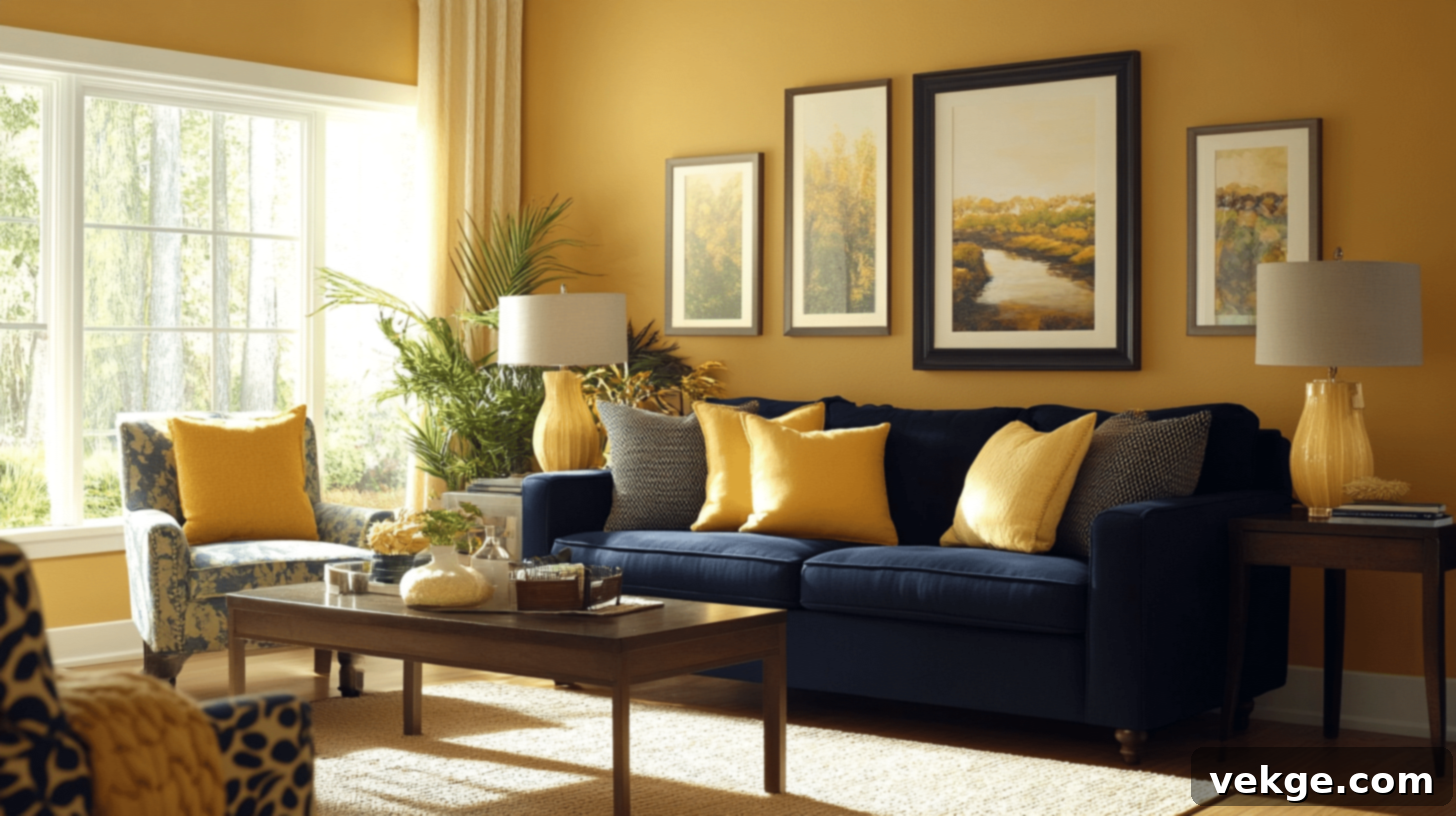
The foundation of a unified room often begins with its color scheme. Select a core palette of two to three primary colors that will serve as your guiding hues. This usually involves a dominant neutral (like white, grey, or beige) for walls and larger furniture, a main accent color for significant pieces or feature walls, and a secondary accent color for smaller decorative items. The key is to distribute these colors strategically throughout the space, ensuring they appear in various elements such as upholstery, artwork, textiles, and accessories. This deliberate repetition creates strong visual connections, making all elements feel inherently related and part of a larger design story, rather than isolated choices. For instance, if your main accent is deep teal, incorporate it into throw pillows, a ceramic vase, and a subtle pattern in your area rug.
2. Harmonize Wood Finishes and Tones
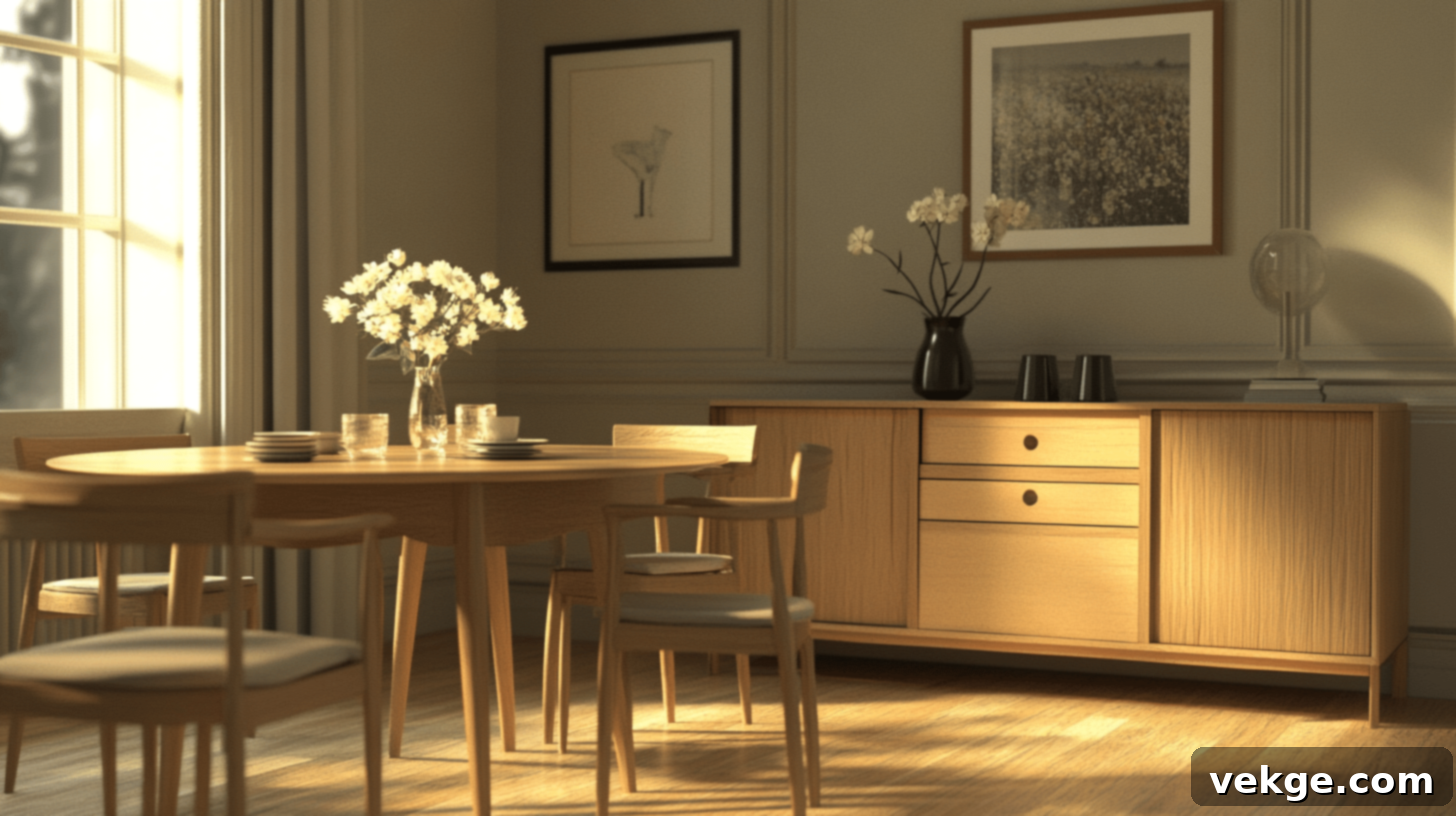
Wood elements, from flooring and trim to furniture and decorative objects, play a significant role in a room’s overall feel. Strive to coordinate these wood finishes so they either match precisely or, more commonly, belong to the same tonal family (e.g., all warm oaks, all cool walnuts, or a consistent light wood aesthetic). Avoid a chaotic mix of vastly different wood tones side-by-side, as this can create visual discord. When wooden furniture pieces, such as a dining table, chairs, and a sideboard, share similar tones or finishes, they instantly establish a sense of order and sophisticated continuity. Even if you’re mixing wood types, ensure their undertones (red, yellow, grey) are compatible to maintain a cohesive look.
3. Maintain Stylistic Consistency
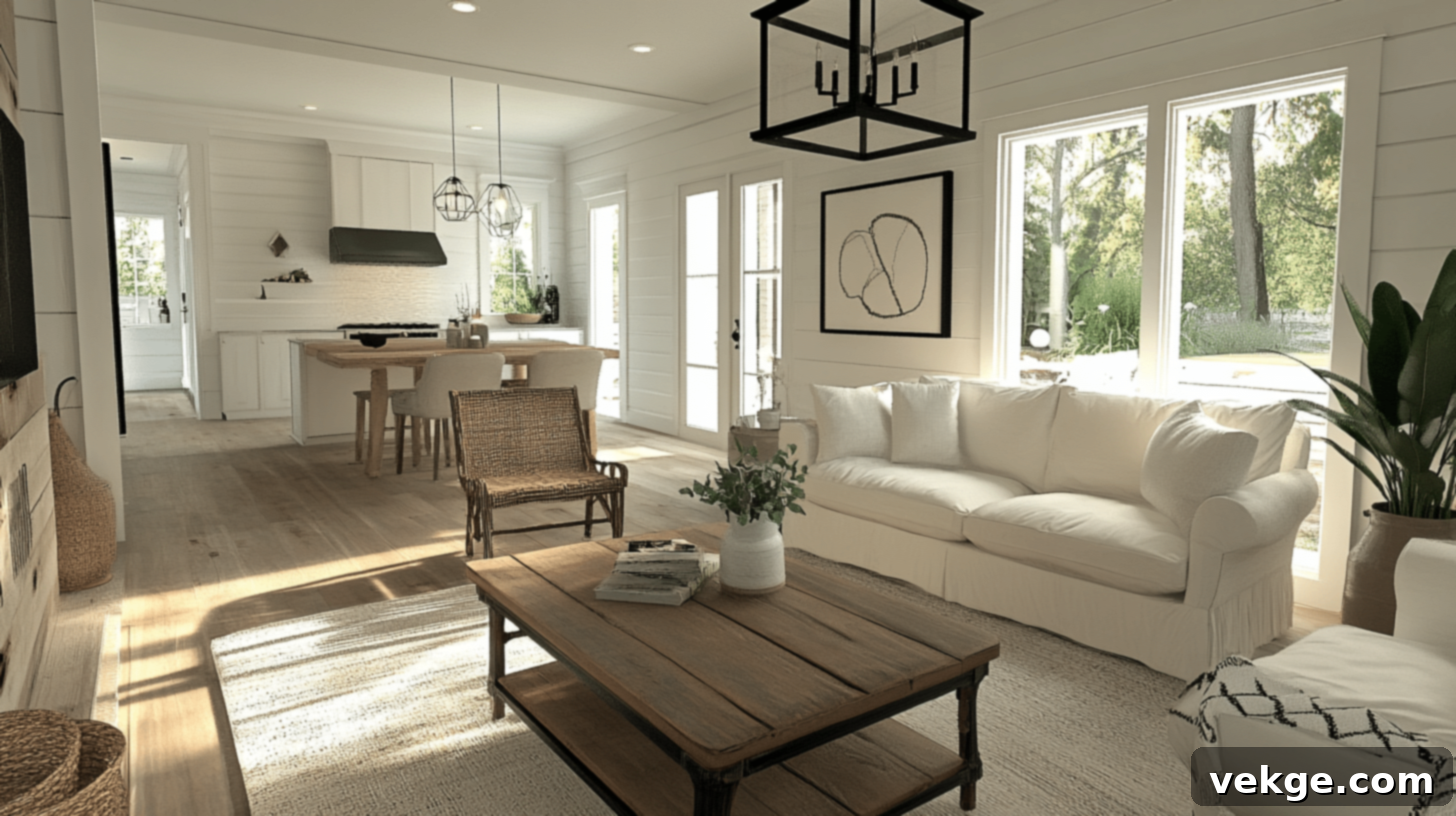
One of the most powerful drivers of unity is a consistent design style. Decide on a primary style for your room—be it modern, traditional, industrial, bohemian, or something in between—and let it guide your furniture and decor choices. While a subtle blend of two complementary styles can be artful, introducing too many disparate aesthetics can quickly lead to a cluttered and incoherent look. When your larger pieces, like sofas, dining tables, and shelving units, all align with a consistent design language, the room feels thoughtfully planned and purposeful. This doesn’t mean everything must be from the same collection, but rather that items should share similar lines, forms, and general aesthetic principles.
4. Create Effective Visual Bridges
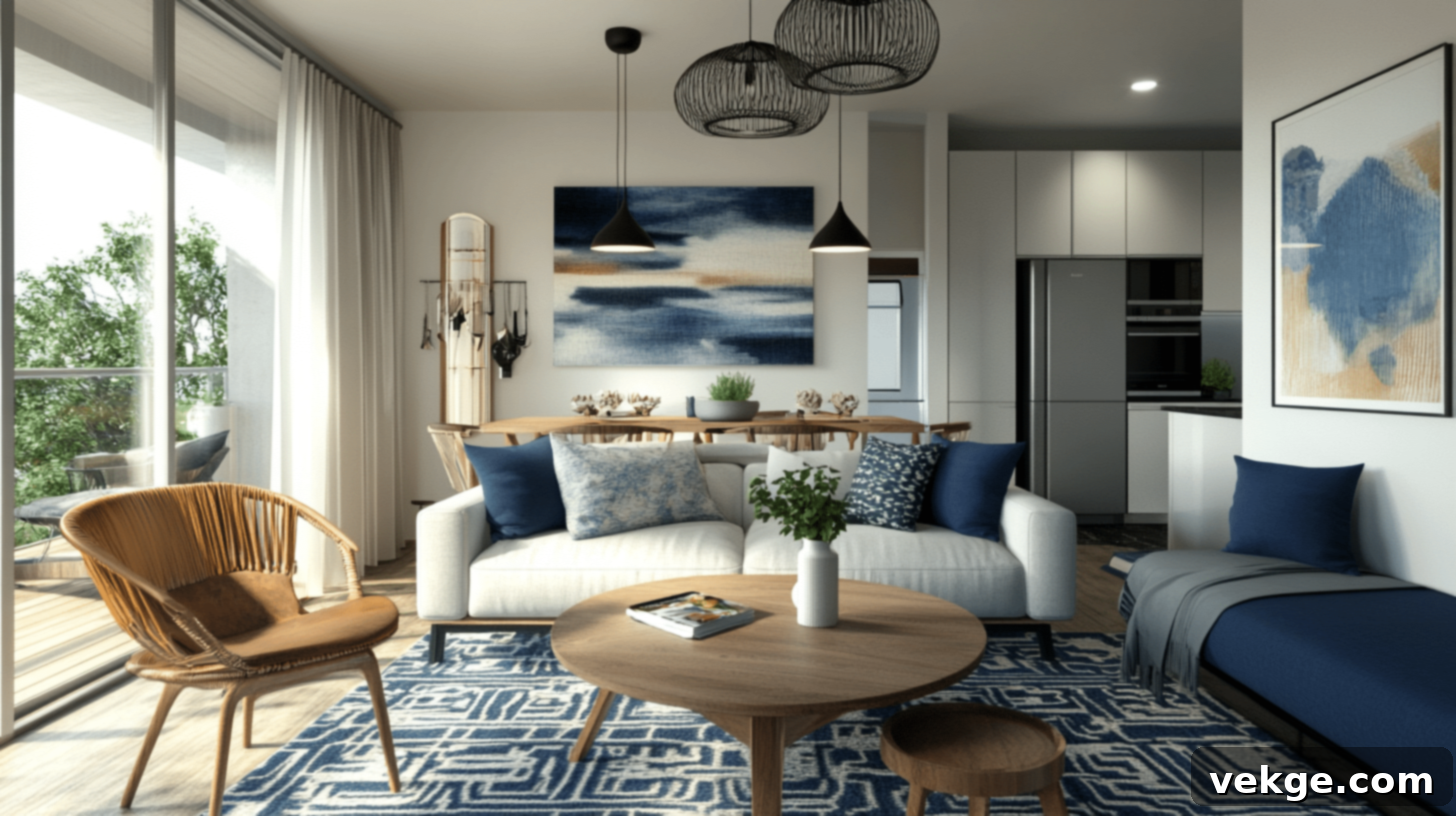
Visual bridges are essential for connecting different zones or elements within a larger space, helping the eye flow seamlessly from one area to another. These can be achieved through various linking elements such as area rugs that define and connect seating arrangements, consistent artwork themes across different walls, or recurring accent colors in pillows, throws, and decorative objects placed in various parts of the room. Imagine a throw blanket on one sofa that matches the color of an accent chair across the room, or a collection of vases on a bookshelf that echoes the material of a coffee table tray. These connecting pieces act as visual anchors, ensuring that even distinct areas feel like integral parts of a larger, unified whole.
5. Prioritize Proportion and Scale Relationships
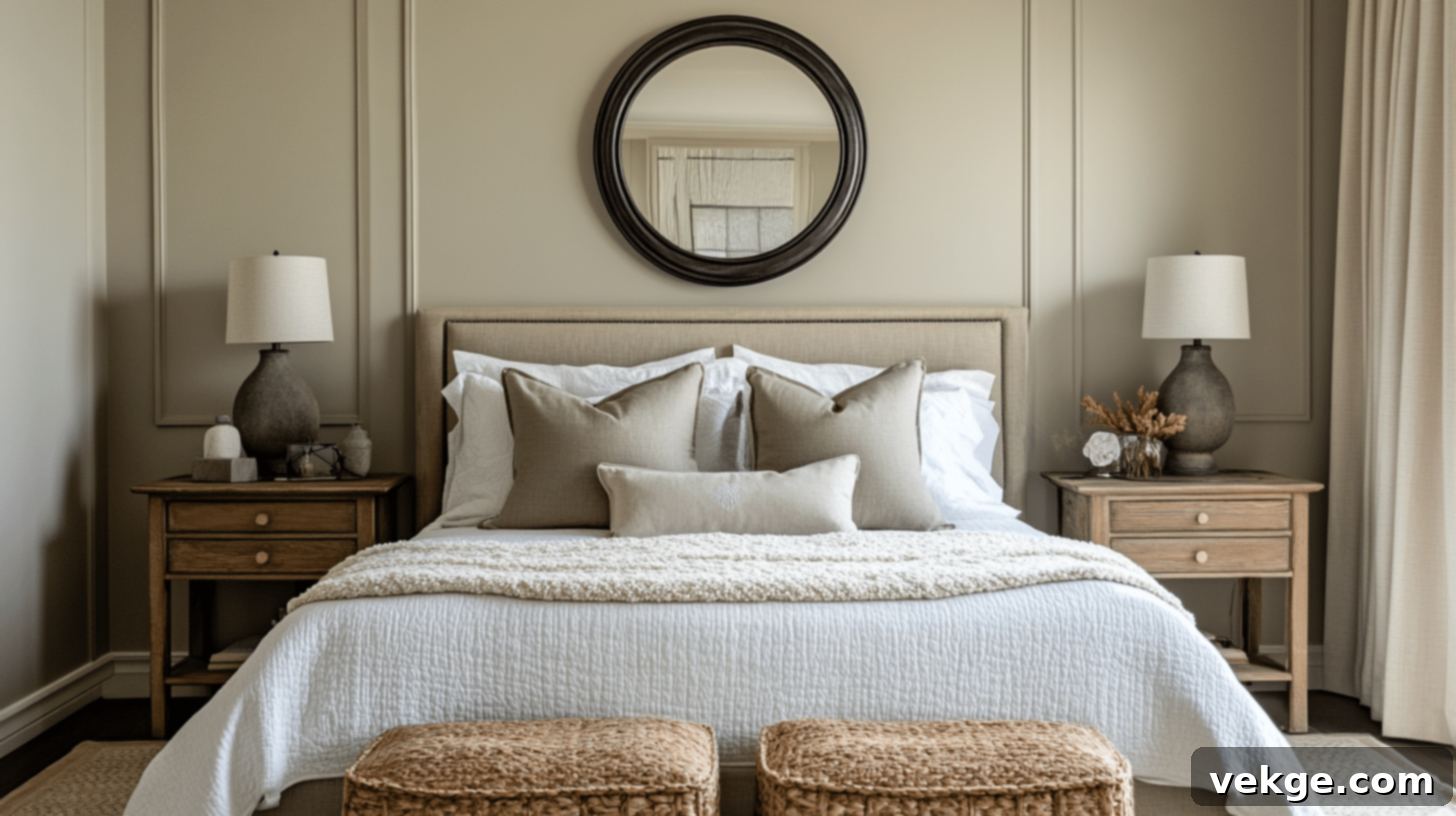
Paying meticulous attention to the size of items relative to each other and to the room itself is fundamental for unity and overall comfort. Furniture and accessories should be in proper proportion, avoiding jarring contrasts like a colossal sectional dominating a tiny room, or miniature art pieces lost on a grand wall. Evaluate how each piece visually interacts with its neighbors. A well-proportioned space feels balanced and inviting, whereas mismatched scale can make a room feel awkward, cramped, or overwhelmingly empty. Always measure your space and your furniture to ensure a harmonious fit before making purchases, creating a layout that respects the physical dimensions of your environment.
6. Unify Hardware Finishes

Often overlooked, the consistent application of hardware finishes can significantly contribute to a room’s unified appearance. Whether it’s the sleek gleam of brushed nickel, the warmth of antique brass, or the understated elegance of matte black, choosing one dominant metal finish (or a very limited, complementary set) for most hardware elements creates a subtle yet powerful connection throughout the space. This applies to light fixtures, door handles, cabinet pulls, furniture legs, and even picture frames. A unified hardware scheme provides a polished, refined touch that subtly reinforces the intentionality of your design, preventing a disjointed or accidental look.
Essential Do’s and Don’ts for Achieving Interior Unity
To reinforce your understanding and help you apply these principles effectively, here’s a quick guide of what to embrace and what to avoid when striving for unity in your home design.
Do’s:
- Do use one dominant pattern strategically and introduce smaller, complementary patterns sparingly to add interest without overwhelming the space.
- Do carry your main accent color into various areas of the room through different elements to create a visual thread and strong connections.
- Do keep the visual heights and weights of furniture balanced around the room to ensure a sense of stability and equilibrium, even with asymmetrical arrangements.
- Do use similar shapes in different sizes or forms (e.g., a round mirror, a circular side table, and a curved sofa arm) to create subtle, repetitive design cues that unify the aesthetic.
- Do declutter regularly to ensure that every item present contributes to the overall unified vision, preventing visual noise.
- Do invest in foundational pieces that align with your chosen style, as these will serve as anchors for the rest of your decor.
Don’ts:
- Don’t mix too many bright, clashing colors in one space without a clear, intentional strategy, as this can lead to visual chaos and diminish unity.
- Don’t combine more than two distinct design styles, especially if they are vastly different, without a masterful approach to bridging them, to avoid a disjointed look.
- Don’t place very different wood tones side by side if they don’t share compatible undertones, as this can create visual friction and disrupt harmony.
- Don’t ignore how items connect visually; always step back and assess the overall composition, looking for opportunities to create links and relationships between elements.
- Don’t overlook the importance of negative space; allowing for open areas is crucial for visual balance and preventing a cluttered feel.
- Don’t buy items in isolation; always consider how a new piece will interact with existing elements in terms of color, style, and scale.
Achieving Unity Across Diverse Design Styles
Unity isn’t confined to a single aesthetic; it’s a universal principle that adapts to and enhances any design style. While the manifestation of unity may differ, its core purpose—to create a cohesive and deliberate space—remains constant. Let’s explore how unity is beautifully integrated into minimalist, traditional, and eclectic interiors.
Minimalist Unity: The Power of Simplicity and Precision
In minimalist design, unity is achieved through a rigorous commitment to simplicity, clean lines, and an uncluttered aesthetic. The focus is on essential elements, where every piece serves a purpose and contributes to a serene, open atmosphere. Unity here is forged by a highly limited color scheme, typically relying on neutrals like whites, grays, and blacks, often with just one carefully selected accent color. Furniture features streamlined forms, often with matching or complementary finishes, and unnecessary ornamentation is stripped away. For instance, a minimalist living room might feature stark white walls, a charcoal grey sofa with simple lines, black metal-framed artwork, and a single vibrant blue armchair. The unity stems from the deliberate absence of excess, the consistent clean geometry, and the restrained color palette, creating a powerful sense of calm and order where every element breathes.
Traditional Unity: Symmetry, Richness, and Timeless Elegance
Traditional interior design embraces unity through a more formal and often ornate approach, prioritizing timelessness and established aesthetics. Here, unity is frequently achieved through symmetry, with elements mirrored across a central axis (e.g., matching lamps on either side of a fireplace or a pair of identical armchairs). Rich, warm wood tones are consistently used across furniture, flooring, and architectural details, lending a sense of classic grandeur. Classic patterns—like damask, toile, or floral motifs—are repeated in textiles and wall coverings, often in a harmonious, complementary palette. Curved shapes for furniture legs, ornate carvings, and coordinated drapery also contribute to the unified, opulent feel. Imagine a traditional dining room with a matching set of dark mahogany chairs, a coordinating buffet, richly patterned drapes, and a consistent warm color scheme; the result is a cohesive, elegant, and historically resonant space.
Eclectic Unity: Blending Diversity with Purpose
Perhaps the most challenging, yet rewarding, style for achieving unity is eclectic design. This style celebrates the mixing of different periods, textures, and cultural influences. The danger, however, is that it can easily become chaotic without a strong unifying thread. In eclectic spaces, unity is not about sameness but about finding common ground amidst variety. Key strategies include: connecting disparate pieces through a consistent color palette (e.g., painting mismatched chairs the same vibrant hue), using a uniform flooring material throughout the space to provide a stable base, or repeating a specific shape or pattern in varied ways (e.g., a recurring circular motif in a rug, mirror, and decorative object). A beautifully unified eclectic bedroom might feature a vintage dresser, a modern bed frame, and global-inspired textiles, all brought together by a unifying shade of deep green used on the walls, in the bedding, and subtly within a patterned throw pillow. The common denominator, carefully chosen, allows individual pieces to shine while contributing to a harmonious whole.
Cultivating Unity in Small Spaces: Maximizing Cohesion
In compact living environments, the principle of unity becomes not just beneficial but absolutely critical. Small spaces are particularly susceptible to feeling cluttered, chaotic, or overwhelming if design elements are disjointed. A strong sense of unity can paradoxically make a small room feel larger, more organized, and significantly more functional, transforming a potentially cramped area into a serene and inviting retreat.
The strategy for unity in small spaces emphasizes simplification and intentional cohesion:
- Restrained Color Palette: Limit your color scheme to perhaps two main colors, with only minimal touches of a third accent. Overuse of colors can visually chop up a small space, making it feel even smaller and more fragmented. Sticking to a monochromatic or analogous palette (colors next to each other on the color wheel) can create a seamless flow.
- Scale-Appropriate Furniture: Choose furniture that is proportionate to the room’s dimensions. Opt for pieces with lighter visual weight, such as those with exposed legs, slender profiles, or made from transparent materials like glass or acrylic. Keeping furniture low to the ground can also enhance the perception of vertical space.
- Light and Openness: Utilize clear or light-colored furniture, walls, and textiles to reflect light and create an expansive, airy feel. Mirrored surfaces can also cleverly expand the perception of space.
- Multi-Functional Furniture: Select multi-purpose pieces (e.g., an ottoman with storage, a sofa bed, a nesting table set) that not only save space but also align stylistically to contribute to the overall unity. Ensure their color, material, and design language connect with other elements in the room. For instance, in a studio apartment, a sleek, modern sofa that converts into a bed should visually complement your compact dining set and minimalist storage solutions.
- Consistent Flooring: Employing the same flooring material throughout a small apartment or open-plan area is one of the most effective ways to create an uninterrupted visual flow, making the entire space feel larger and more interconnected.
- Strategic Repetition: Even in a small area, subtle repetition of a shape, texture, or color can tie elements together without adding clutter. For example, if you have a circular coffee table, echo that shape in a small wall clock or a round plant pot.
By thoughtfully applying these unity strategies, even the most modest of spaces can be transformed into highly functional, aesthetically pleasing, and remarkably cohesive homes.
Wrapping Up: Embrace Unity for a Home That Truly Feels Right
Ultimately, unity in interior design is the secret ingredient that transforms a mere collection of rooms into a truly inviting and cohesive home. It’s the thoughtful orchestration of every element, ensuring that furniture, colors, textures, and decor not only coexist but actively support each other to create a single, harmonious narrative. When achieved, unity imbues your living spaces with a profound sense of purpose, tranquility, and visual appeal, fostering an environment where you can truly relax and feel at peace.
To recap, remember these essential takeaways: meticulously select a consistent color palette, harmonize your wood and metal finishes, maintain a clear and consistent design style, and always seek to create visual bridges that connect different areas and elements. Pay close attention to the principles of repetition, balance, rhythm, and appropriate proportion and scale. These aren’t just rules; they are tools that empower you to craft stunning and functional interiors.
Don’t feel overwhelmed by the prospect of redesigning your entire home at once. Begin small, perhaps by tackling one room that feels particularly disjointed—your living room, bedroom, or even a home office. Refer back to the comprehensive checklist and the do’s and don’ts we’ve provided in this guide. Take “before” photos to document your starting point, implement your changes with intention, and then capture the “after” transformation. You’ll undoubtedly be astonished by the profound positive impact a unified room can have on your mood and the overall ambiance of your home.
Your home doesn’t need to conform to an impossible ideal of perfection, but it absolutely benefits from making sense as a cohesive whole. By embracing the principles of unity, you’re not just decorating; you’re creating a sanctuary that reflects thoughtful design and provides an undeniable sense of belonging and comfort. Start your journey towards a more unified home today, and experience the remarkable difference it makes.
